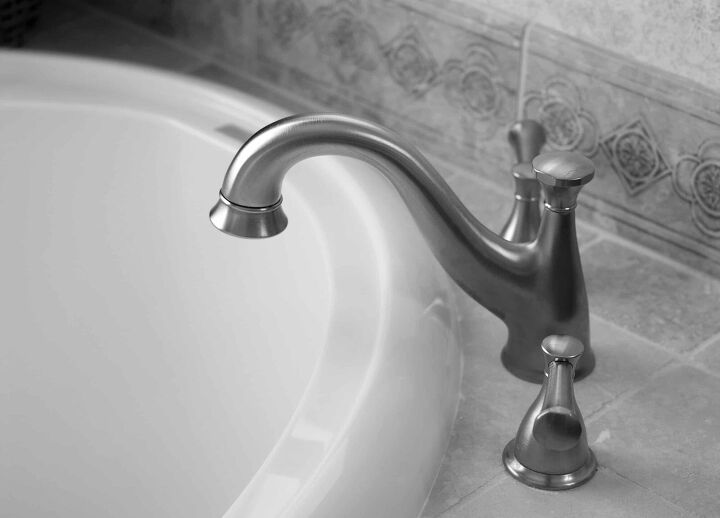How To Replace A Roman Tub Faucet With No Access Panel

When it comes to DIY fixes in the home, many people shy away from skilled trade work like plumbing. What if it goes wrong? Believe it or not, you can do some significant upgrades to plumbing fixtures without risking a big flood.
To replace a Roman Tub faucet with no access panel, first, turn off the water, and loosen the set screw to pull off the old spout. Do the same to remove the handles. Then, place your o-rings around the cartridges and spout. Apply plumbers putty before putting on the new spout and handles.
If you’ve ever installed a sink faucet before, replacing a Roman tub faucet will be a walk in the park. In fact, changing out a faucet is even easier than installing a new one. In this case, all of the messy water supply lines are “below deck” while the pieces you’re changing out are on top.
Do You Need a Faucet, Fixture, or Pipe Repair or Replacement?
Get free, zero-commitment quotes from pro contractors near you.

What Is A Roman Tub Faucet?
When it comes to choosing plumbing fixtures, the options can be dizzying. You need to consider types of faucets, different finishes, and how to mount them. But for a bathtub, a Roman tub faucet is a solid, classic choice.
On a Roman tub faucet, the handles and faucet attach to the deck of the tub. These faucets can’t be mounted on the rim of a standard bathtub or to an adjacent wall. Instead, you must install them on a tub deck or the wide lip of a drop-in tub.
People most commonly use Roman tub faucets for jacuzzi or drop-in tubs. These faucets require three or more faucet holes for installation, especially if paired with a hand shower attachment. Roman faucets have a signature arched spout but can come in a range of handle configurations and aesthetic finishes.
Don’t Want To Read About How To Replace A Roman Tub Faucet, Watch This Video Instead.
Replacing A Roman Tub Faucet
When replacing an existing Roman tub faucet, you’ll only need the trim kit. Plumbing fixtures come in two parts: the trim and the valves.
In this scenario, you won’t be going “below deck” to replace the valves. Therefore, save yourself some money, and buy only the trim if possible.
Tools for the Job
- Allen wrench or hex key
- Putty knife
- Flathead or Phillips head screwdriver
- Plumber’s putty (optional)
- Rag
- New faucet trim kit
Step 1: Turn off the water
- If you see an access panel on the side of the tub, turn the water off from that point. There might be an access panel, and you just don’t realize it. Sometimes these access panels are hidden in the closet of an adjacent room.
- However, if there is no panel, turn off the water from the house’s main water line. You’ll likely find the shut-off near your water heater.
- Turn on the faucets all the way, letting them run until all the water has drained. This step prevents you from getting burned by hot water or soaked by anything left in the pipes.
Step 2: Out with the old
- Loosen the set screw with a hex key or Allen wrench. The set screw is the small, headless screw at the faucet’s base. If you don’t see it at first, check in the back: they are designed to be inconspicuous.
- Pull straight up on the old spout to remove it. Unscrew any remaining elements at the base of the faucet with your screwdriver. You may need to slip a putty knife between the base of the faucet and tub deck if it’s been caulked or sealed.
- Repeat this same process with the handles. The set screw may be in the back, like the faucet, or at the very top of the handle. If the screw is hiding underneath a decorative cap, use your flathead screwdriver to pry it loose.
- If you’re having trouble finding a set screw, try twisting the base counterclockwise. (Remember, lefty loosey and righty-tighty!)
- Scrape any remaining putty or caulk off the tub deck, so you’ve got a clean slate to install your new faucet.
Step 3: In with the new
- Plumbing fixtures use a rubber o-ring to ensure a tight seal at the bottom. Find these rings in your trim-out kit and place them around the plumbing cartridges and spout pipe. Make sure the rings go all the way to the bottom, so they sit flush with the tub deck.
- Plumber’s putty is an extra safeguard against leaks. First, check to see if your model of Roman tub faucet recommends using putty.
- Place the new handles over the existing cartridges. Twist the base clockwise (righty-tighty!) or secure the set screw with your hex key. Each model will have slightly different installation specs.
- Slide the spout over the faucet pipe and press down. This style of spout likely won’t turn. When the base is flush with the tub deck, tighten the set screw.
Step 4: Test it out, and dive in
- Turn the water back on, turn on your new faucet, and look for any leaks. If you see even the slightest bit of water seepage, be sure to address it. Small leaks can grow over time and cause big problems.
- If necessary, retrace your steps until you find the source of the excess water. When your faucet and handles are leak-free, your new tub filler is ready to use!
Related Questions
What is a Roman soaking tub?
The Roman tub filler gets its name from the Roman soaking tub. A Roman soaking tub is the ultimate place to unwind after a long day, styled after the fabled ancient Roman baths.Though it can’t come close to the glamour, relaxation, and pleasure of a traditional Roman bathhouse, this tub tries. It’s deep enough to soak up to your chin and can sometimes accommodate two people. It’s also deeper, wider, and sometimes longer than a standard tub.There are no fancy jets or some utilitarian shower here. The purpose of this tub is as its name implies: to close your eyes and soak it in.
What is a cartridge, and how do I know if I need to change it?
Cartridge valves regulate water flow and temperature. There are several kinds of valves that make faucets work, and cartridges are one of the most common. Cartridge valves offer more precise control than others. You can replace these valves relatively easily if need be. But how do you know when it’s time to swap them out?If you’re just replacing the trim, as detailed above, there’s no need to replace the cartridge unless it’s damaged. However, if you’re having difficulty regulating temperature or water flow, that’s a sign that it’s time to change your cartridge. If you open up the faucet and see a cloudy white substance, the culprit is mineral deposits. Soaking the cartridge in white vinegar should help make it as good as new. However, if you see cracks or other visible damage on the cartridge, it’s time to replace it.Note: Cartridges are specific to each plumbing fixture, so you’ll need to special order them from a manufacturer or specialty store. Keep in mind that cartridges aren’t usually the culprit of leaks. Leaks typically signify a faulty o-ring or washers.
Do You Need a Faucet, Fixture, or Pipe Repair or Replacement?
Get free, zero-commitment quotes from pro contractors near you.

Relax and Unwind
Creating a bathroom that’s both functional and aesthetically pleasing is a homeowner’s dream. With a little know-how and a keen eye for design, anything is possible. Small changes like swapping out fixtures can make a big difference.
Now sit back, relax, and enjoy your beautifully renovated bathroom while you luxuriate in your Roman soaking tub. Don’t forget the bubble bath!
Related Guides

Stacy Randall is a wife, mother, and freelance writer from NOLA that has always had a love for DIY projects, home organization, and making spaces beautiful. Together with her husband, she has been spending the last several years lovingly renovating her grandparent's former home, making it their own and learning a lot about life along the way.
More by Stacy Randall













![10 Best Cordless Leaf Blowers – [2022 Reviews & Ultimate Guide]](https://cdn-fastly.upgradedhome.com/media/2023/07/31/9070789/10-best-cordless-leaf-blowers-2022-reviews-ultimate-guide.jpg?size=350x220)













